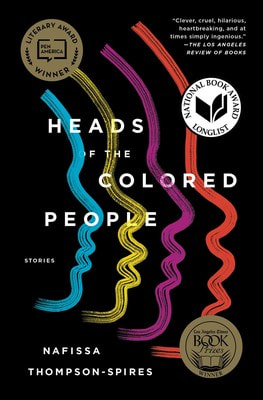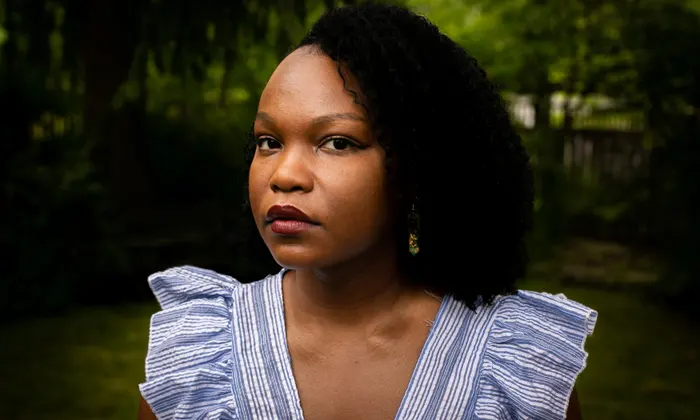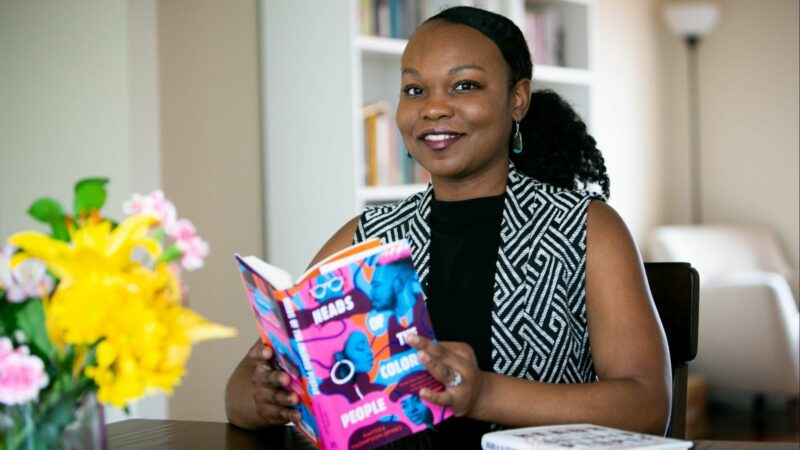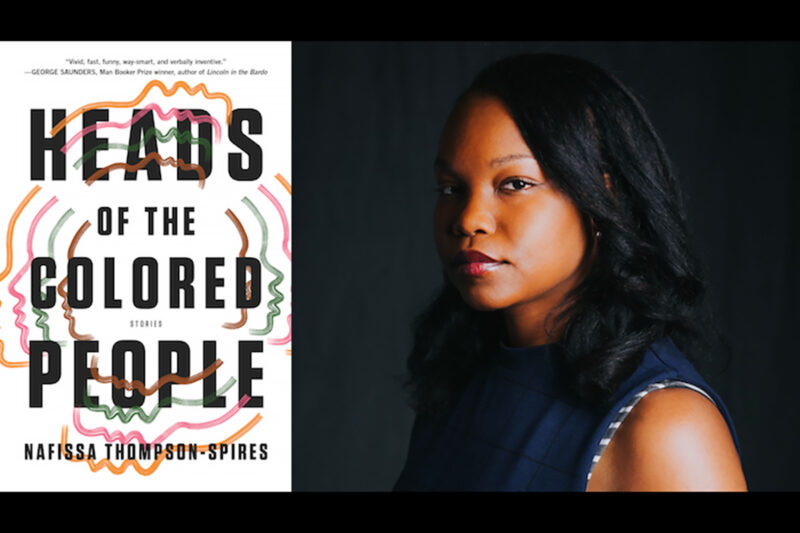

Nafissa Thompson-Spires
Award-winning Fiction Author
PEN Open Book Award

Readings &
Lecture Topics
-
It’s Kind of a Funny Story: (Ethical) Humor and Satire
-
Writing Difference Well
-
Belles Lettres: The Epistolary Story
-
Barely Made it Here to Begin With: Sustaining a Writing Life with Invisible and/ or Chronic Illness
- An Evening with Nafissa Thompson-Spires
Biography
“Vivid, fast, funny, way-smart, and verbally inventive, the vastly talented Thompson-Spires creates a compelling surface tension made of equal parts skepticism towards human nature and intense fondness of it. Located on the big questions, [this writing] is full of heart.” –George Saunders
“A bold new voice, at once insolently sardonic and incisively compassionate, asserts itself amid a surging wave of young African-American fiction writers. Thompson-Spires’ auspicious beginnings auger a bright future in which she could set new standards for the short story.” –Kirkus Review, starred
Born and raised in Southern California, Nafissa Thompson-Spires is the author of the short story collection Heads of the Colored People (Simon and Schuster, 2019), winner of the PEN Open Book Award, the Whiting Award, the Los Angeles Times Book Award for First Fiction, longlisted for the 2018 National Book Award, and a finalist for the Kirkus Prize and Los Angeles Times Book Prize. Her debut novel, a tongue-in-cheek murder mystery about the power of storytelling and the bonds women forge with each other, is forthcoming with Simon and Schuster.
Of her collection of stories, Kiese Laymon says: “Nafissa Thompson-Spires has taken the best of what Toni Cade Bambara, Paul Beatty, Morgan Parker and Junot Diaz do plus a whole lot of something we’ve never seen in American literature, blended it all together and giving us one of the finest short story collections I’ve ever read. The super thin lines between terror, intimacy, humor and hubris are masterfully toed, jumped and ultimately redrawn in the most exciting and soulful fiction I’ve read this century. The nation needed Heads of Colored People 40 years ago. Thankfully, Nafissa Thompson-Spires gave it to us now.”
Thompson-Spires was a 2016 participant of the CallalooWriter’s Workshop, a 2017 Tin House fellow, and a 2017 Sewanee Writer’s Conference Stanley Elkin Scholar. Her work has appeared in publications such as The White Review, Los Angeles Review of Books Quarterly, StoryQuarterly, Paris Review Daily, The Cut, and The Root, among others.
After earning PhD in English from Vanderbilt University, Thompson-Spires completed her Master of Fine Arts in Creative Writing from the University of Illinois. She teaches at Cornell University, and lives in New York.
Short Bio
Born and raised in Southern California, Nafissa Thompson-Spires is the author of the story collection Heads of the Colored People (Simon and Schuster, 2019). Her forthcoming novel is under contract with the same publishers. Thompson-Spires was a 2016 participant of the CallalooWriter’s Workshop, a 2017 Tin House fellow, and a 2017 Sewanee Writer’s Conference Stanley Elkin Scholar. Her work has appeared in publications such as The White Review, Los Angeles Review of Books Quarterly, StoryQuarterly, Lunch Ticket, and The Feminist Wire, among others. She earned a PhD in English from Vanderbilt University and a Master of Fine Arts in Creative Writing from the University of Illinois.
Visit Author WebsiteVideos
Publications
Heads of the Colored People
Short Story, 2022
Each captivating story plunges headfirst into the lives of utterly original characters. Some are darkly humorous—two mothers exchanging snide remarks through notes in their kids’ backpacks—while others are devastatingly poignant. In the title story, when a cosplayer, dressed as his favorite anime character, is mistaken for a violent threat the consequences are dire; in another story, a teen struggles between her upper middle class upbringing and her desire to fully connect with so-called black culture.
Articles & Audio
Read What’s In Print
• Nafissa Thompson-Spires: ‘I wanted to see stories about nerdy black people’ – Washington Post
• What Is a Sketch but a Chalk: An Interview with Nafissa Thompson-Spires – Newfound
• Nafissa Thompson-Spires Is Taking Black Literature in a New Direction – Electric Literature
• 5 Things About Your Book: Disarming Humor in Heads of the Colored People – New York Times
• What to Read When Celebrating Black History – The Rumpus
• Review: Heads of the Colored People – Harvard Review
Listen to Audio
• Heads of the Colored People is ‘GMA’s’ Buzz Pick – Good Morning America
• Nafissa Thompson-Spires: Heads of the Colored People – KCRW
• Heads Of The Colored People Takes On The Pressures Of Being ‘The Only One’ – NPR
Selected Writings
• Read “On No Longer Being a Hysterical Woman” – The Paris Review
Suicide, Watch (originally published in Dissent Magazine)
Jilly took her head out of the oven mainly because it was hot and the gas did not work independently of the pilot light. Stupid new technology. And preferring her head whole and her new auburn sew-in weave unsinged, and having no chloroform in the house, she conceded that she would not go out like a poet.
But she updated her status, just the same:
A final peace out
before I end it all.
Treat your life like bread,
no edge too small
to butter.
Jilly was not a poet or even an aspiring one. She just liked varying her posts as much as possible. She had 1,672 Facebook friends and 997 Twitter followers, and she collected them like so many merit badges. The beautiful mixed friend with the blond curls meant that pretty people liked Jilly, too. And being friends with the mahogany-colored guy with the enviable and on-trend tapered beard with all the followers on Instagram—the one who liked one of her baby pictures a year ago—was almost the same as having a fine black boyfriend when all the research and a popular video said it was a good thing black women already knew how to dance to “Single Ladies” because that was going to be their song forever.
Her friends included her mailman; five of the checkout boys at Stater Brothers on Riverside Avenue, three from Foothill in Fontana, and one from the grocer Ralphs in Rialto; all sixty-four of her mom’s friends from high school, many of whom had known her in utero; the podiatrist who removed the bursitis from her left big toe in seventh grade; her therapist from high school; her therapist from undergrad (her current therapist had a no-friending policy); all her high school teachers; the professor with whom she slept and two with whom she didn’t; her third-grade best friend; her birth buddy from the hospital, who had been born exactly one minute after her, and who had been particularly difficult to find since her name had changed; as many mutual friends as said yes; and countless people who’d sent her LinkedIn requests, despite her disdain for that particular networking ploy.
Jilly determined to wait at least four hours before checking the status of her farewell post so she wouldn’t look desperate, but then she remembered that she didn’t have long left, so she waited five minutes and checked her phone.
Four notifications:
JULIA WEINBERG, KAREN GRANT, AND 2 OTHER PEOPLE RECENTLY LIKED YOUR STATUS.
JESSICA GIVEN [that was Jilly’s mom] COMMENTED ON YOUR STATUS.
REMINDER: YOU HAVE 1 EVENT THIS WEEK.
Six more people had liked her other status, about a juice cleanse she was considering, from earlier in the day.
She didn’t know how to interpret the likes on her poem. Was it too cryptic? Were people happy she was saying goodbye, sanctioning her death? Jilly checked the third notification on the list. The Studio Center art show was on Friday, and she had already picked out an outfit. She drew her feet under her hips and sank deeper into the couch. She ignored the text message and two subsequent phone calls from her mother, who must have seen the poem and interpreted it properly. So it wasn’t too cryptic. She opened the clock app and set her phone timer to one hour, then got up and put her phone in the microwave, a trick she’d taught herself to keep from checking it obsessively, because the act of having to retrieve the phone was supposed to be such a bother that she’d get tired of doing it.
Since she was already in the kitchen, Jilly removed the pouch from the utility drawer—she liked calling it that, a utility drawer, though many of the things in it (the stubs of crayons too small to use, pennies stuck together, widowed locks and keys) were no longer useful—then removed the box cutter from the pouch. She sat back on the couch, trying to decide on the best place to be found with slit wrists. A bloody mess in the kitchen would make it look unplanned, her life taken abruptly in a fit of desperation. The shower, on full blast while she sat under its stream, would make less mess but look desperately premeditated. The bathtub, where the blood would pool—she couldn’t even think of the bathtub. She had seen Harold and Maude in a sociology class, and it scared her, all kidding aside. Most blood did, in fact. She put the knife back in its pouch and thought it a shame, because it was a cute knife and pouch, with matching kawaii cupcakes on the handle and flap.
She checked her pages again, this time on her laptop.
Pills might not work the first time. All she had were six pseudoephedrine-free gelcaps, and they seemed most likely to upset her stomach. There was no alcohol in the house to mix with anything, because she drank only when people could watch. She was really funny when she drank, or at least she tried to be. Her impression of Shirley Temple as Heidi was a big hit. “I’ve got to see the grandfather, I’ve just got to,” she would say, bunching up her lips and hunching her shoulders. She’d tap-danced on a table once or twice to applause.
On the bright side, if the suicide attempt failed and she had to have her stomach pumped, she would lose at least ten pounds, and that would be better than last year’s colonic, the pictures of which had elicited an awkward silence from her online friends. Weight loss would make for a great status update.
Razor wounds were better, she decided, because even though there would be blood, she’d pass out before she saw much of it, and if she didn’t die, she could take pictures of the scars. Actually, scarring might be much better than attempted or completed suicide because there’d be questions to answer, like “What happened? Who did that to you? Are you okay? Do you need help with anything? You didn’t do that to yourself, did you?” She committed to becoming a cutter for an hour or so, like Ellie on Degrassi, and to make a few marks up one arm and then post a picture. She eyed her marmalade cat, Sherman, sitting on the window’s lily-print cushion. The cuts would have to be deep enough so they wouldn’t look like mere scratches but not so deep as to draw too much blood.
The first tiny cut hurt way more than it looked like it did when Ellie tried it, and Jilly was hungry. She put the knife back in its pouch, again, licked at her wrist—though there was no blood, only a superficial abrasion—rifled through the pantry, and finding nothing to snack on, sat back on the couch.
She had read somewhere, a book in Psychology 101 or something, that people who told everyone they were going to do it were just asking for permission, but she didn’t need or want permission.
The thing about Jilly—and this is something she’d feared about her life from adolescence onward—was that there was no backstory. Nothing exciting or terrible had ever happened to her, and if there was any oppression for her to overcome, it only grazed her but never lingered. She had been followed in posh boutiques many times by Asian and white women and twice by black women, but those were the only examples of racism she could remember experiencing. She knew that she should feel discontentment, connected to a large chain of disenfranchisement or systemic persecution—it’s not that black death and the news of the world didn’t touch her spirit—but she was somewhat ashamed to say, in therapy or publicly, that the bulk of her discontentment came from having very little about which to be discontented. Her mother was pushy but stable, her father claimed her, her friends were attentive if tired. It was she who broke up with her boyfriend, not the other way around, and they were still Facebook friends. She got a dozen “Are you okay?” direct messages after she changed her status from “in a relationship” to “single.” And she had a full network of supportive people, however superficial most of their interactions were. The support she lacked felt more fundamental, and she didn’t know where to seek it.
The picture Jilly had posted the day before had gotten only four likes and two comments: “HOTT,” from an acne-prone creep she’d known in high school; and “your welcome” when she replied to his post. Perhaps that was what set her off, not disregard for the difference between “you’re” and “your,” but the shallow comments. She thought the picture, which she’d taken in her bathroom mirror from her camera phone, warranted a better response, at very least because of the interesting angle from which she took it. The sideways shot showed her, fingers making a peace sign, lips making a fish face, in a cream-colored skirt that stopped at the upper thigh and offset her smooth brown skin, and a purple bandeau top that might or might not have been half of a bikini.
She put her laptop down and pulled her knees toward herself when an idea came to her. It was Thursday, after all. She posted “TBT” and a link to a YouTube video of “Dead and Gone,” to feel out the traffic, then waited for the notifications to start, for the thumbs to erect small monuments.
Within twenty minutes, a red square announced fourteen likes, no comments. She didn’t know how to read this. Were they saying they wanted her dead and gone or that they liked T.I., or Justin Timberlake?
She waited ten minutes and tried a second video, then another, posting from her laptop. These things worked best in a quick succession that made them seem stream of consciousness. “Another one: ‘Give Up the Ghost’ by Immature, feat. Bizzy ee.”
Oh and can’t forget Bone Thugs: ‘Crossroads.’
Jilly could boast of few superlatives that might be included in her obituary. In eighth grade, she was voted Most Photogenic by her peers and earned a quarter-page feature in the school yearbook. But she could never regain that former glory. By high school, she was one of four Prettiest Girls, and two of them were thicker than she was, and she wasn’t even the only black girl to win the honor. An undergrad boyfriend said she was the best kisser he’d ever had, but he cheated on her. A stranger at the mall said her feet were “the most adorable feet I’ve ever seen.” She wasn’t sure if the compliments of a creeper even counted. What did she have to show for her life, other than the near perfections of her appearance?
She did actually feel depressed now, thinking about it, dying and all. No one would associate her with Sylvia Plath. She wouldn’t look like the Lady of Shalott with her new weave framing her face as she lay on her back in a boat, or even Anne of Green Gables as the Lady of Shalott or even Megan Follows as Anne of Green Gables as the Lady of Shalott, because her natural hair wasn’t even red, and anyway, she’d read that when black women died it wasn’t glamorous, and people didn’t make metonymic literary connections about them, even to lynching—as they did for black men; black women’s bodies just died, out of frame, and that made her sadder.
The laptop pinged. Another notification.
Love this song! You’re on a roll today, girl.
If Jilly were to run a content analysis of the style and type of posts that got the most responses, it would emerge that faux Ebonics always ranked high, especially up until the past year or so: “Peep this foos.” A picture of herself wearing red oversize Sally Jessy Raphael glasses and making a fish face was one of her all-time highs, with 384 likes and 73 comments; maybe yesterday’s reenactment photo, in the white skirt and purple bandeau, was just played out. Current events worked, if they were interesting, deep stories she’d seen on Yahoo News about medicines that actually made you sicker or soy milk filled with estrogenic compounds and neurotoxic proteins. Posts about television were even better: “Kerry Washington is SO gorgeous. I want that outfit . . . and that one. Go, Shonda!” Instant 56 likes. Cat videos outperformed babies, which followed closely behind, but delicate posts about family and #blessings could be tricky, because people didn’t want to see how happy you were too often, even if you were making it all up.
Jilly returned to the kitchen and scanned the refrigerator. Several of her friends were on antidepressants and had attempted suicide before, and they got a lot of positive responses for their candor. Jilly had asked her third therapist for antidepressants twice, but she said, “No, Jilly, I’m still not that kind of doctor. And you aren’t depressed, just narcissistic, and there are, so far, no medications for that.”
In third grade, after reading The Secret Garden, Jilly had asked her mom—and subsequently two doctors—for a back brace to treat her scoliosis, like Colin. They had all laughed and said, “What an imagination,” in those adult voices.
Her second therapist said, “You’re not a hypochondriac; you just have too much time on your hands. Try volunteering somewhere.”
The old people in the nursing home looked uninterested when Jilly tried out her tap-dancing and Shirley Temple imitations. A man with long ear-and-nostril hairs fell asleep midact, and his snoring was so obnoxious that Jilly paused the show to try to rouse him.
Jilly thought going to and posting vaguely about therapy at least left something up to the imagination of her followers. She mentioned her experiences there frequently in her “Think About It” Tuesday posts, with captions like, “Who says black people don’t go to therapy?” and #therapy. If she mentioned it often enough, without saying why she went, people could fill in a sexier disease than narcissism, which you couldn’t exactly tell anyone you had, because it made you look bad, and she didn’t even have the malignant kind or the official personality disorder; even her narcissism was pastel pink, kawaii cute.
Jilly was really hungry now, and dying of starvation wasn’t a quick suicide option. She had a cabinet full of groceries, some even gourmet, but a meal of microwave ramen seemed more fitting for the occasion than, say, chicken tenders and broccoli. She chose one of the Thai-flavored packages from the cupboard.
She had forgotten to put water in her ramen a year ago and heated the dry noodles and powder sauce to a smoky black mess that left her kitchen smelling like burned fish for a week but which made for an excellent photo. 227 likes.
During senior year, she’d known a girl named Fatima who had bulimia, and though Fatima didn’t otherwise eat dairy, she often binged on big servings of nacho cheese. Jilly didn’t envy any sickness that made you throw up or poop uncontrollably or look so gaunt that you weren’t even pretty anymore, but it did seem that everyone else had a label, that their illnesses got more attention, that there was something chic about them.
One of her friends—not online, but her real friend—Carl from the eleventh-grade art club, at Eisenhower High School, had even died. He hadn’t asked anyone for permission or left a note. His mother and friends, even Jilly, had wept openly at his funeral.
Jilly shivered, thinking about Carl in the closed casket, and his mom’s eyes, glassy yet hollow. She took out a porcelain bowl, which she’d ordered from Etsy, printed with kawaii lollipops.
She’d heard people, including Carl’s sister, say that suicide was the ultimate act of selfishness, that it left everyone else behind to clean up the mess. Jilly wasn’t sure how she felt about that. It was Carl’s body and therefore his choice. And no matter how you died, it left a mess for someone else to clean up. If Carl had died in a car accident or from cancer, his family would have still asked why, and they would have still been responsible for the funeral arrangements.
Jilly chose a porcelain soup spoon and floral-printed chopsticks and placed them next to the bowl. Who would make the arrangements for her? Her mother didn’t even know her favorite flowers, and she would probably want Jilly buried in an Ann Taylor dress suit with a bedazzled collar. The auburn sew-in weave was cute, but Jilly wasn’t sure she wanted to be memorialized in it forever. Who would run her online tribute page or make sure the right people came to the service? And what good was a funeral if she couldn’t, like Tom and Huck, witness the mourners and see how much they had all loved her?
She chastised herself for her stupidity and chuckled. She was not going to kill herself, certainly not today. Maybe she would try volunteering again, try reading to the elderly. She could wear a costume and visit sick children or attractive young men in the hospital; she could start brainstorming the outfits and completing the necessary applications as soon as she finished her dinner. The pictures she would post. Nothing was more fulfilling, it occurred to her, than giving back to others and letting people know about it.
She poured water from the filter pitcher into the bowl, over the dehydrated noodles and powder, and put the whole deal into the microwave and pressed start before she remembered her phone.
Later, those who mentioned her asked whether anyone had noticed anything different about her. Were there any warning signs? And why did she set the whole house and the poor ginger cat on fire? Why did she use the phone instead of a more traditional way? But in the moment, Jilly saw only the bright crimson of the explosion. It came in four red pops, like notifications, friend requests.



